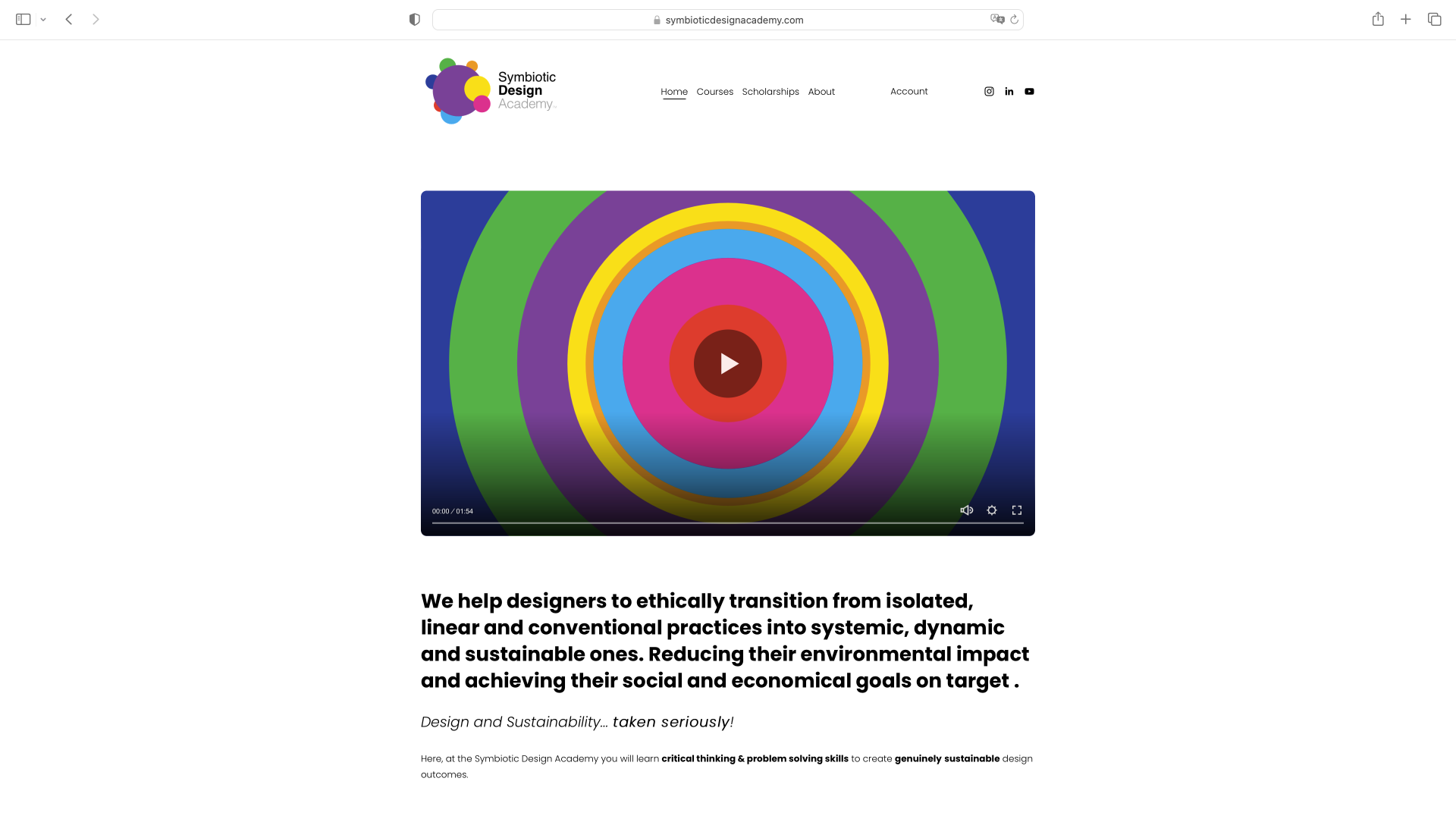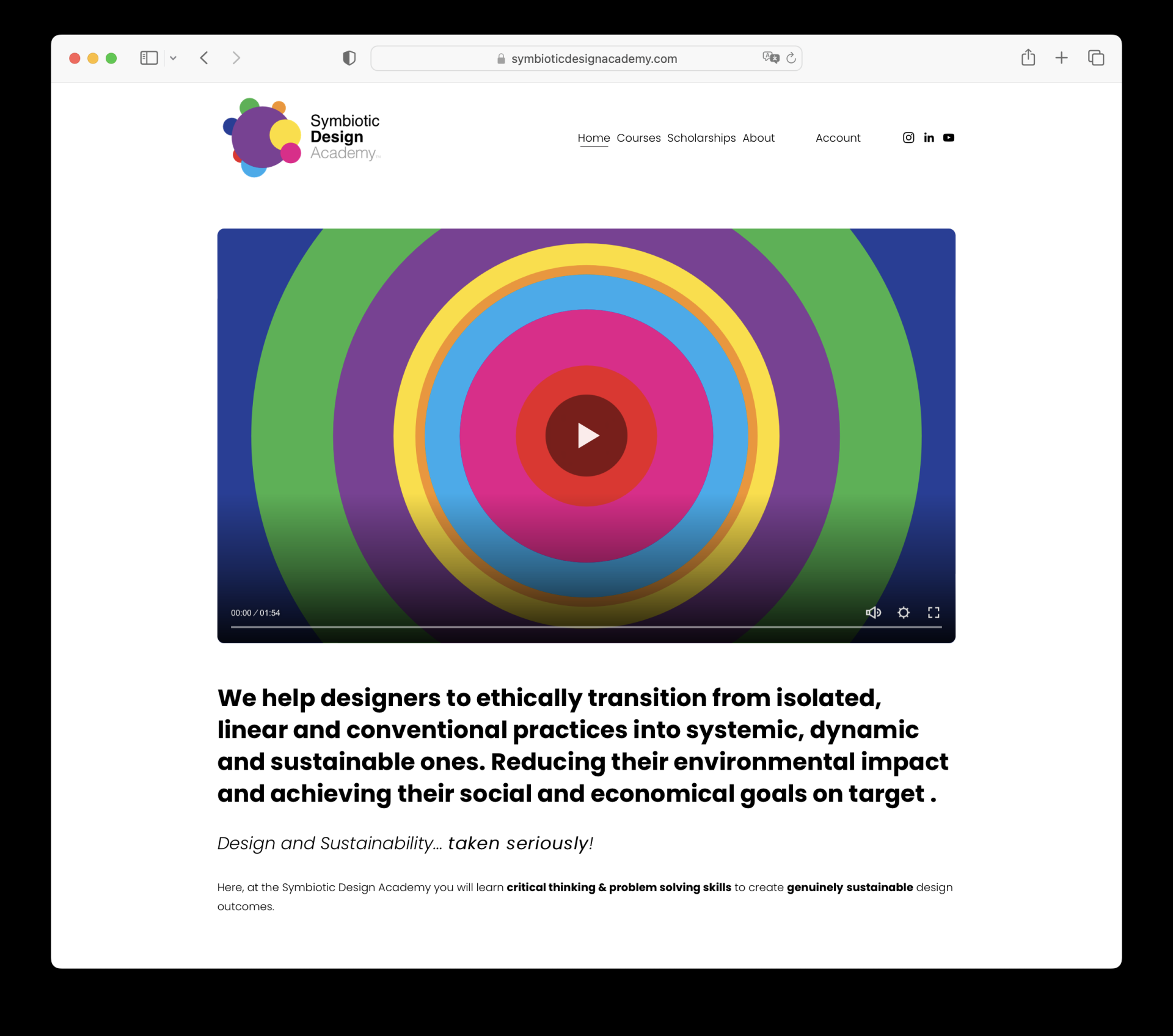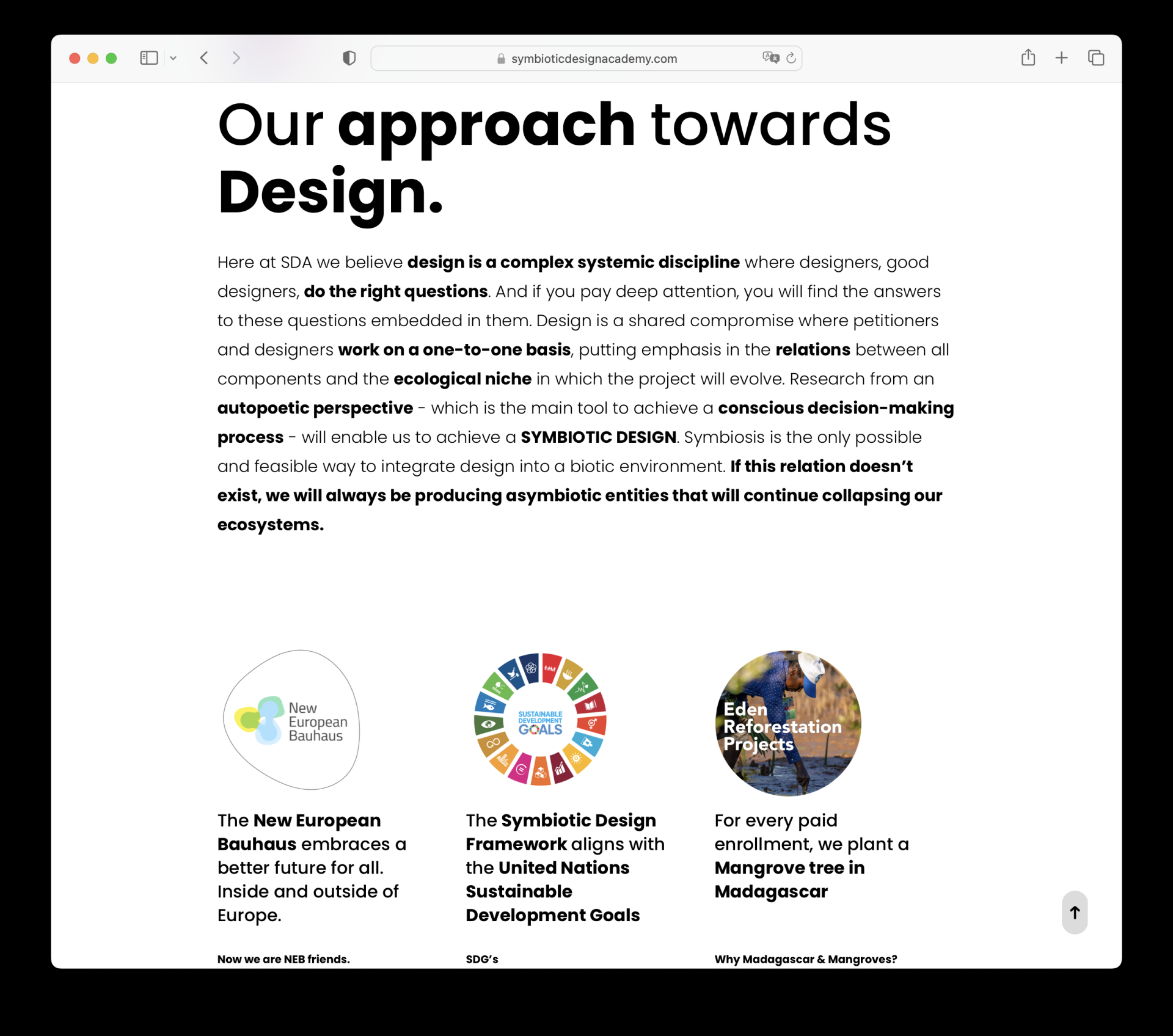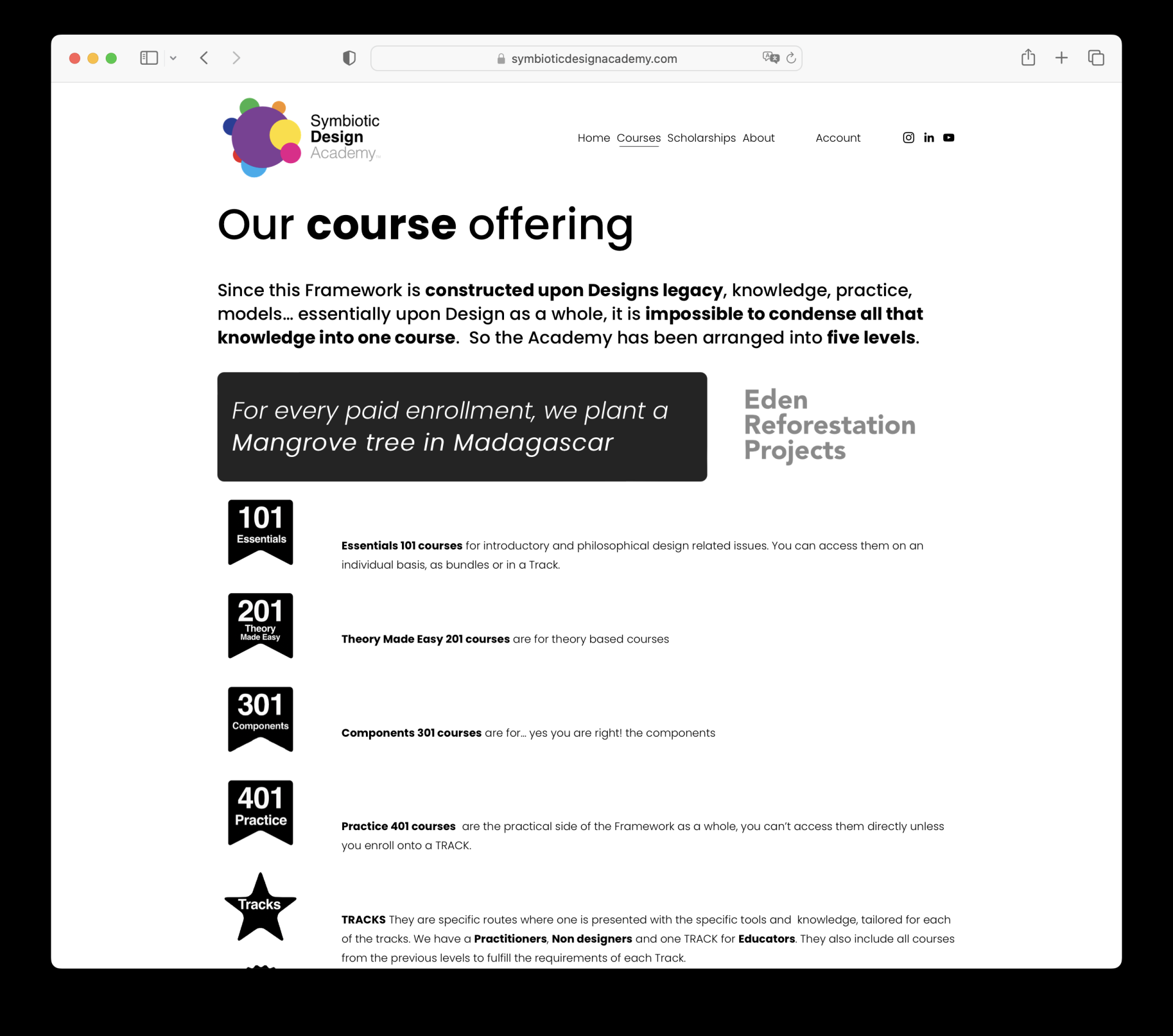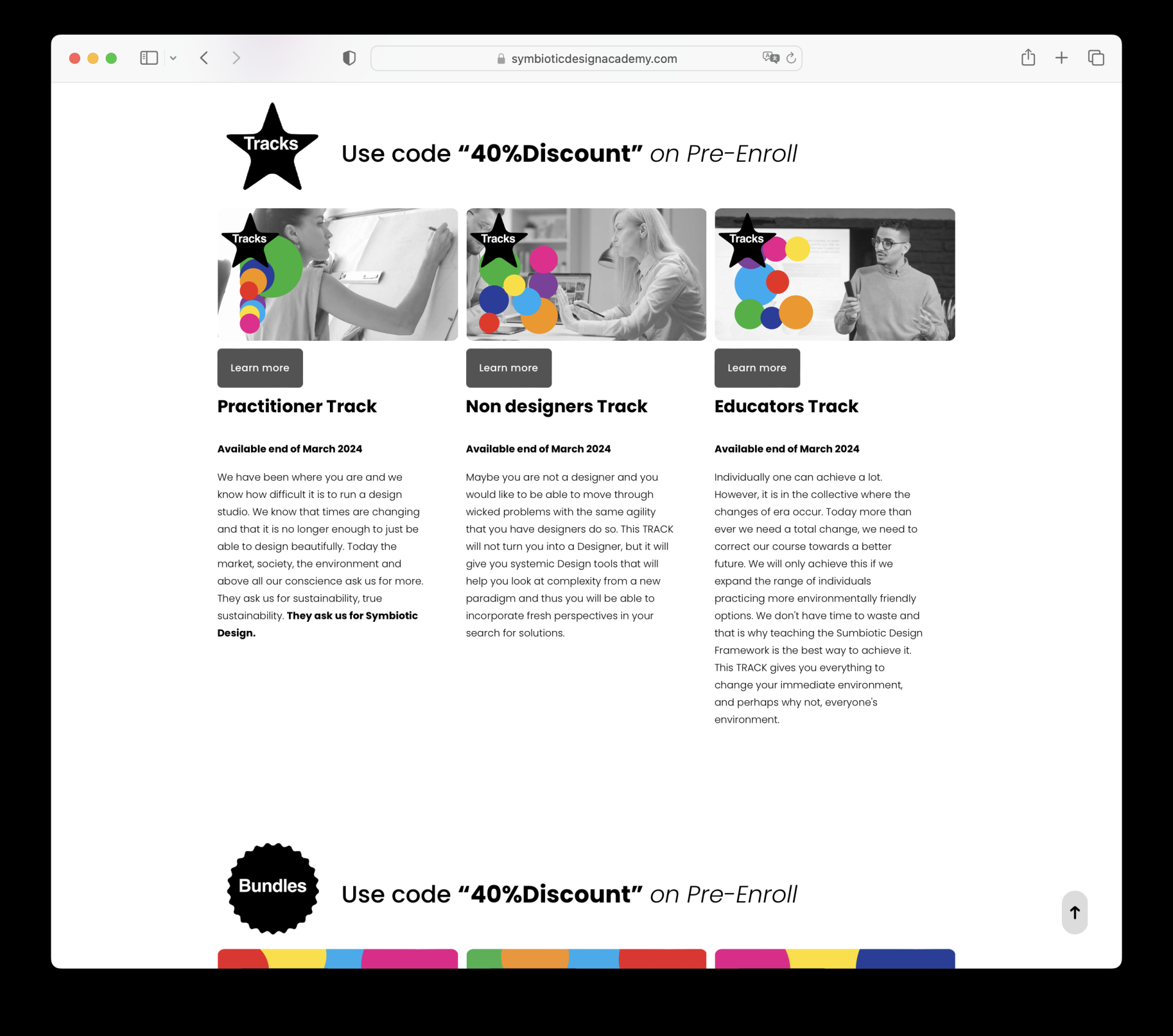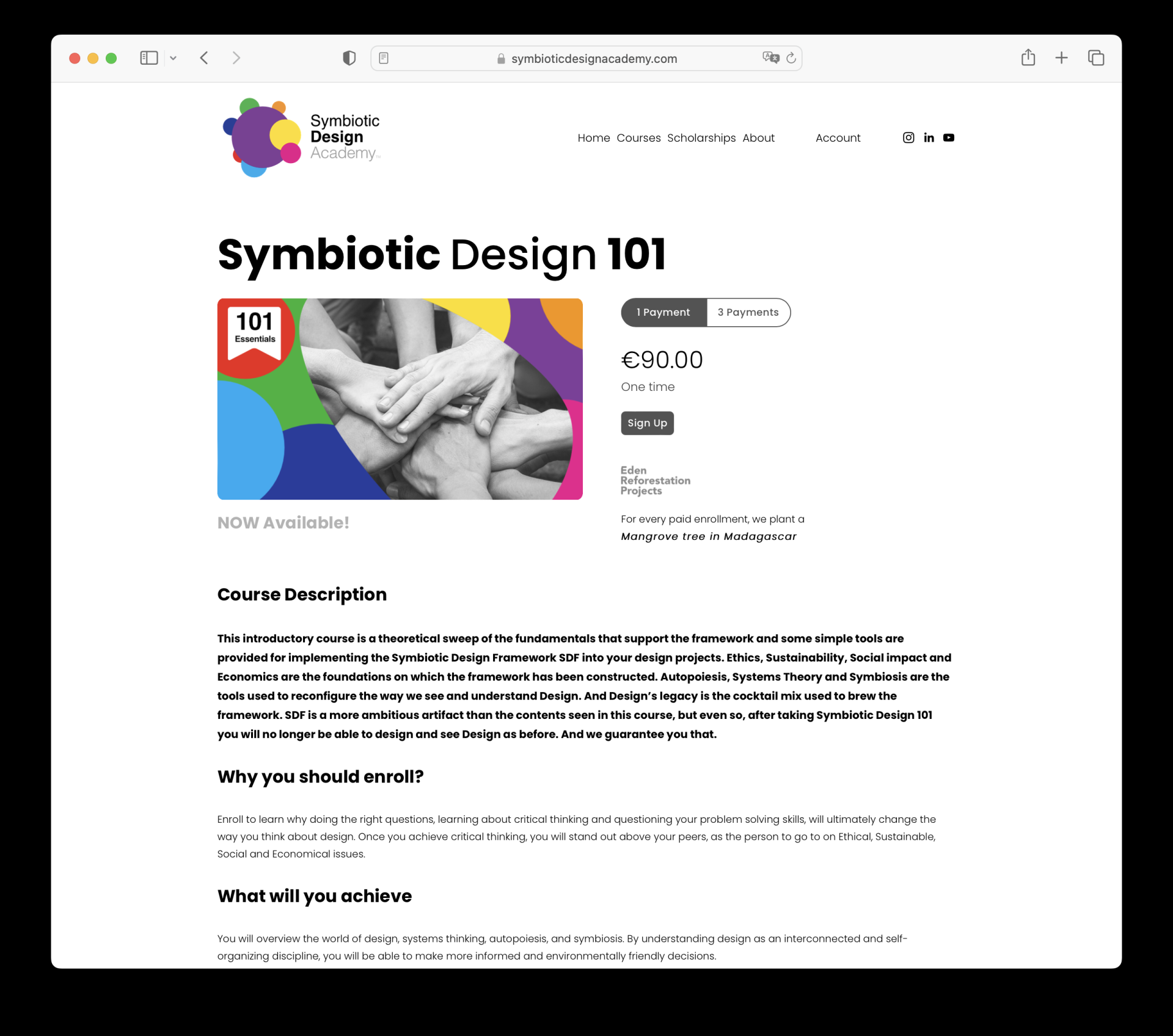Symbiotic Design Academy
Basic information
Project Title
Symbiotic Design Academy
Full project title
Symbiotic Design Academy SDA
Category
Shaping a circular industrial ecosystem and supporting life-cycle thinking
Project Description
We create courses to help designers to ethically transition from isolated and conventional practices into dynamic and sustainable ones, reducing their environmental impact and achieving their social and economical goals on target.
We bring Symbiotic Design to all disadvantaged corners and with greater urgency for intervention.
We bring Symbiotic Design to all disadvantaged corners and with greater urgency for intervention.
Geographical Scope
Cross-border/international
Project Region
CROSS-BORDER/INTERNATIONAL: Albania, Austria, Belgium, Bulgaria, Bosnia and Herzegovina, Croatia, Cyprus, Czechia, Denmark, Estonia, Finland, France, Germany, Greece, Hungary, Ireland, Italy, Kosovo, Latvia, Lithuania, Luxembourg, North Macedonia, Malta, Montenegro, Netherlands, Poland, Portugal, Romania, Serbia, Ukraine, Slovakia, Slovenia, Spain, Sweden
Urban or rural issues
It addresses urban-rural linkages
Physical or other transformations
It refers to other types of transformations (soft investment)
EU Programme or fund
Yes
Which funds
Other
Other Funds
Next Generation EU
Description of the project
Summary
The Symbiotic Design Academy aims to promote sustainable and inclusive design practices through the Symbiotic Design Framework. The target group includes designers, researchers, and professionals in the field of design. The specific objective is to shift design processes from linear or circular models to a nonlinear and dynamic approach, based on the principles of autopoiesis, systems theory, and symbiosis. The academy provides through online courses knowledge and tools to understand and apply the framework, enabling designers to create outcomes that work in harmony with the environment. The achieved outcomes include increased awareness of the ethical, environmental, social, and economic aspects of design, as well as the ability to ask the right questions and make informed decisions for more sustainable design practices. In the context of the New European Bauhaus, the academy aligns with the initiative's goal of transforming different sectors, including the built environment, towards a sustainable and inclusive future. From the perspective of eudaimonia, the academy promotes the well-being and flourishing of individuals and communities through design practices that prioritize ethics, sustainability, and social inclusion.
Key objectives for sustainability
The key objectives of the Symbiotic Design Academy align with the principles of sustainability as expressed in the New European Bauhaus initiative. The Academy aims to promote a fundamental change in design practices towards a sustainable and inclusive future. It focuses on the ethical, environmental, social, and economic aspects of design, emphasizing the need for a paradigm shift in the field.
Through its courses, the Academy equips designers with the knowledge and tools to implement the Symbiotic Design Framework, which fosters a nonlinear and dynamic approach to design. By integrating concepts such as autopoiesis, systems theory, and symbiosis, the Academy encourages designers to consider design in biological and complex system terms.
The courses offered by the Academy address the four mottos of sustainability: environmental, social, economic, and ethical. They provide a comprehensive understanding of these aspects and guide designers in applying them to their work. By emphasizing the importance of collective effort, compassion, empathy, and creativity, the Academy promotes a holistic approach to sustainability.
The impact of the Academy's courses can be seen in the transformation of design practices. Designers who have completed the courses have reported a shift in their mindset and approach, leading to more sustainable and impactful design outcomes. The Academy's emphasis on the ethical motto as the foundation for sustainability sets it apart from other initiatives, making it exemplary in promoting a comprehensive and holistic understanding of sustainability in design.
Through its courses, the Academy equips designers with the knowledge and tools to implement the Symbiotic Design Framework, which fosters a nonlinear and dynamic approach to design. By integrating concepts such as autopoiesis, systems theory, and symbiosis, the Academy encourages designers to consider design in biological and complex system terms.
The courses offered by the Academy address the four mottos of sustainability: environmental, social, economic, and ethical. They provide a comprehensive understanding of these aspects and guide designers in applying them to their work. By emphasizing the importance of collective effort, compassion, empathy, and creativity, the Academy promotes a holistic approach to sustainability.
The impact of the Academy's courses can be seen in the transformation of design practices. Designers who have completed the courses have reported a shift in their mindset and approach, leading to more sustainable and impactful design outcomes. The Academy's emphasis on the ethical motto as the foundation for sustainability sets it apart from other initiatives, making it exemplary in promoting a comprehensive and holistic understanding of sustainability in design.
Key objectives for aesthetics and quality
The key objectives of the Symbiotic Design Academy align with the principles of the New European Bauhaus initiative, focusing on aesthetics, quality of experience, and cultural benefits through design. The Academy aims to foster a sustainable and inclusive future by promoting innovative and holistic approaches to design.
Through its courses, the Academy encourages designers to embrace the Symbiotic Design Framework, which emphasizes the interconnectedness of design components and their relationships with the environment. By adopting this framework, designers can create outcomes that work in harmony with the world around them, minimizing harm and maximizing benefits.
The impact of the Academy's courses can be seen in the transformation of designers' perspectives and practices. By shifting from linear or circular models to a nonlinear and dynamic approach, designers are able to achieve true sustainability. The courses provide designers with the necessary knowledge and tools to apply the principles of the Symbiotic Design Framework to their work, resulting in designs that are not only aesthetically pleasing but also environmentally and socially responsible.
In the context of eudaimonia, the Symbiotic Design Academy exemplifies the pursuit of human flourishing and well-being through design. By prioritizing sustainability, inclusivity, and the improvement of living environments, the Academy contributes to the overall quality of life for individuals and communities. The Academy's focus on aesthetics and cultural benefits ensures that design is not only functional but also enriching and meaningful, enhancing the overall experience and satisfaction of individuals.
Through its courses, the Academy encourages designers to embrace the Symbiotic Design Framework, which emphasizes the interconnectedness of design components and their relationships with the environment. By adopting this framework, designers can create outcomes that work in harmony with the world around them, minimizing harm and maximizing benefits.
The impact of the Academy's courses can be seen in the transformation of designers' perspectives and practices. By shifting from linear or circular models to a nonlinear and dynamic approach, designers are able to achieve true sustainability. The courses provide designers with the necessary knowledge and tools to apply the principles of the Symbiotic Design Framework to their work, resulting in designs that are not only aesthetically pleasing but also environmentally and socially responsible.
In the context of eudaimonia, the Symbiotic Design Academy exemplifies the pursuit of human flourishing and well-being through design. By prioritizing sustainability, inclusivity, and the improvement of living environments, the Academy contributes to the overall quality of life for individuals and communities. The Academy's focus on aesthetics and cultural benefits ensures that design is not only functional but also enriching and meaningful, enhancing the overall experience and satisfaction of individuals.
Key objectives for inclusion
The key objectives of the Symbiotic Design Academy align with the principles of inclusion as expressed in the New European Bauhaus initiative. The Academy aims to promote accessibility and affordability for all individuals, ensuring that anyone can participate in the courses and benefit from the knowledge and skills offered. In addition, the Academy embraces inclusive governing systems, allowing for diverse voices and perspectives to be heard and incorporated into decision-making processes.
Through its courses, the Symbiotic Design Academy has successfully met these objectives by providing a wide range of educational opportunities that cater to different backgrounds and abilities. The courses are designed to be accessible both in terms of content and delivery, ensuring that individuals from various socio-economic backgrounds can engage with the material. The Academy also fosters an inclusive learning environment, encouraging collaboration and dialogue among participants.
From the perspective of eudaimonia, the Symbiotic Design Academy exemplifies the principles of well-being and flourishing. By promoting sustainability, ethical practices, and social responsibility, the Academy equips individuals with the knowledge and skills to create positive change in their communities and contribute to a more inclusive and equitable society. The impact of the courses can be seen in the transformative projects and initiatives that participants undertake, addressing real-world challenges and promoting the well-being of both humans and the environment.
Through its courses, the Symbiotic Design Academy has successfully met these objectives by providing a wide range of educational opportunities that cater to different backgrounds and abilities. The courses are designed to be accessible both in terms of content and delivery, ensuring that individuals from various socio-economic backgrounds can engage with the material. The Academy also fosters an inclusive learning environment, encouraging collaboration and dialogue among participants.
From the perspective of eudaimonia, the Symbiotic Design Academy exemplifies the principles of well-being and flourishing. By promoting sustainability, ethical practices, and social responsibility, the Academy equips individuals with the knowledge and skills to create positive change in their communities and contribute to a more inclusive and equitable society. The impact of the courses can be seen in the transformative projects and initiatives that participants undertake, addressing real-world challenges and promoting the well-being of both humans and the environment.
Results in relation to category
Implementing the Symbiotic Design framework offers several benefits. Firstly, it promotes sustainability by considering the ethical, environmental, social, and economic aspects of design. This ensures that design outcomes minimize harm to the environment and contribute positively to society. Secondly, the framework encourages a holistic and systems-based approach to design, enabling designers to understand and leverage the interconnectedness of various components and their relations. This leads to more effective and innovative design solutions.
Direct beneficiaries of implementing the Symbiotic Design framework include designers themselves, as it provides them with a structured and comprehensive approach to their work. It also benefits clients and organizations by helping them achieve sustainable and socially responsible outcomes. Indirect beneficiaries include the communities involved in the production of the products, as the framework promotes social and environmentally conscious design practices, and society as a whole, as it encourages the creation of products and services that meet the needs of individuals and communities in a sustainable manner.
Direct beneficiaries of implementing the Symbiotic Design framework include designers themselves, as it provides them with a structured and comprehensive approach to their work. It also benefits clients and organizations by helping them achieve sustainable and socially responsible outcomes. Indirect beneficiaries include the communities involved in the production of the products, as the framework promotes social and environmentally conscious design practices, and society as a whole, as it encourages the creation of products and services that meet the needs of individuals and communities in a sustainable manner.
How Citizens benefit
Designers community have played a crucial role in the Symbiotic Design Academy project through their active involvement and participation. The participatory methodology used during the creation of the framework ensured that their voices and perspectives were heard and incorporated into the project. The creation of the framework took a span of nearly eight years of Ph.D research and then a field research during the complete duration of the World Design Capital in Valencia 2023. Interviews, surveys and documental research were the main ways of collecting data. Then several workshops were created to test the accuracy of the proposal.
We have created a Scholarship program for those unable to afford the tuition. Our first recipient is the School of Visual Communication, enabling a group of their teacher to follow the Educators Track. As part of our commitment to helping Ukraine recover from Russia's invasion. We believe that our framework's values - ethics, sustainability, social impact, and economics - could help them to overcome the challenges they are going through and create positive changes within their community and Ukraine as a whole. We are following several sustainability activist in Africa to offer them a Non-Designers Track scholarship (no decisions made yet).
We have created a Scholarship program for those unable to afford the tuition. Our first recipient is the School of Visual Communication, enabling a group of their teacher to follow the Educators Track. As part of our commitment to helping Ukraine recover from Russia's invasion. We believe that our framework's values - ethics, sustainability, social impact, and economics - could help them to overcome the challenges they are going through and create positive changes within their community and Ukraine as a whole. We are following several sustainability activist in Africa to offer them a Non-Designers Track scholarship (no decisions made yet).
Physical or other transformations
It refers to other types of transformations (soft investment)
Innovative character
The differentiating factor of the SDA lies in the teaching of a unique and proprietary framework developed by the Gonzalo Raineri Ph.D in Design. The framework is called Symbiotic Design Framework and is the result of six years of research around design and sustainability. It is based on a juxtaposition between design and biology, which allows us to visualize the necessary components to ensure an environmentally friendly result.
If you want to learn about the framework, please access the following link and take the course "Symbiotic Design 101" for free using the code NEB-PRIZES
https://www.symbioticdesignacademy.com/101-symbiotic-design
If you want to learn about the framework, please access the following link and take the course "Symbiotic Design 101" for free using the code NEB-PRIZES
https://www.symbioticdesignacademy.com/101-symbiotic-design
Disciplines/knowledge reflected
Designers and other members of the sustainability community were engaged through various means such as interviews, surveys, and workshops, where they were given the opportunity to share their experiences, ideas, and concerns related to design and sustainability. Their input helped shape the framework and its components, ensuring that it addressed their needs and aspirations.
Six years of Ph.D research that involved documental research and hundreds of interviews and surveys, with an additional one year of field research during the World Design Capital Valencia 2022 where the genesis of the framework. The symbiotic Design framework is construction upon Designs historical, Theoretical and practical heritage, including less represented minorities in an effort to contribute towards decolonization of design as a discipline.
Six years of Ph.D research that involved documental research and hundreds of interviews and surveys, with an additional one year of field research during the World Design Capital Valencia 2022 where the genesis of the framework. The symbiotic Design framework is construction upon Designs historical, Theoretical and practical heritage, including less represented minorities in an effort to contribute towards decolonization of design as a discipline.
Methodology used
The Symbiotic Design Framework's core action is the identification and management of the different components and mainly the relationships involved in a design process. By offering a guide to observing and managing these elements, it is guaranteed that no areas are left unconsidered when designing. These neglected areas are responsible for environmental damage and social injustices in terms of equity. Taking the term equity in the entire broad spectrum of the word.
Among the objectives of the Symbiotic Design Academy are to facilitate and guide professionals with interests around sustainability. For this, eight components and a countless number of variables are provided, on which the existing relationships between them become evident. In this way, we are taught to ask the correct and relevant questions for each particular project that allow us to make informed decisions from an ethical and common good perspective (social, environmental and economic, among others).
If we consider only as an example one of the eight components that must be present in every design process, the “temporal component” and within this the variable “life cycle”, there are aspects that design does not take care of. The communities and environments that participate beyond outside of visible time span (when we possess and use the product), meaning the communities involved in the extraction of materials, manufacturing of the products and subsequent disposal generally suffer the damage and injustice of the omissions carried out by the design. The benefits of the product are only taken advantage of by its users. The Symbiotic Design Academy visualizes and guides so that this does not happen, creating the conditions so that the benefits are distributed equitably throughout the human and natural environment that surrounds a product. This allows us to provide a tool capable of addressing the United Nations sustainable development goals (SDGs) and embracing NEB's ideals
Among the objectives of the Symbiotic Design Academy are to facilitate and guide professionals with interests around sustainability. For this, eight components and a countless number of variables are provided, on which the existing relationships between them become evident. In this way, we are taught to ask the correct and relevant questions for each particular project that allow us to make informed decisions from an ethical and common good perspective (social, environmental and economic, among others).
If we consider only as an example one of the eight components that must be present in every design process, the “temporal component” and within this the variable “life cycle”, there are aspects that design does not take care of. The communities and environments that participate beyond outside of visible time span (when we possess and use the product), meaning the communities involved in the extraction of materials, manufacturing of the products and subsequent disposal generally suffer the damage and injustice of the omissions carried out by the design. The benefits of the product are only taken advantage of by its users. The Symbiotic Design Academy visualizes and guides so that this does not happen, creating the conditions so that the benefits are distributed equitably throughout the human and natural environment that surrounds a product. This allows us to provide a tool capable of addressing the United Nations sustainable development goals (SDGs) and embracing NEB's ideals
How stakeholders are engaged
The impact of this involvement has been significant. By including the design community in the project, the Symbiotic Design Academy has fostered a sense of ownership and empowerment among the participants. They feel that their voices matter and that they have a stake in creating a more sustainable future. We are sure this level of involvement has will led to a greater acceptance and adoption of the framework within the design community and society at large. Overall, the participatory approach has contributed to the project's future success and the promotion of eudaimonia, as it prioritizes the well-being and flourishing of individuals and communities.
Global challenges
The rise of Neoliberalism brought about a shift in power dynamics, as the market became the ultimate decision-maker. Influential figures like Hayek and Friedman championed this ideology, elevating capital to a position of authority. However, rather than empowering individuals, this paradigm stripped us of our humanity and freedom of choice. We transformed from Homo Sapiens into Homo Pecunia - beings defined by money instead of our true selves.
As a consequence of our actions we have reached the Anthropocene, human actions have altered atmospheric, geologic, hydrologic, biospheric and other earth systems processes. And this affirmation is based on overwhelming global scientific evidence. This is probably the largest wicked problem we confront as a specie. But it is not the only one and the Symbiotic Design Framework can tackle them all.
As a consequence of our actions we have reached the Anthropocene, human actions have altered atmospheric, geologic, hydrologic, biospheric and other earth systems processes. And this affirmation is based on overwhelming global scientific evidence. This is probably the largest wicked problem we confront as a specie. But it is not the only one and the Symbiotic Design Framework can tackle them all.
Learning transferred to other parties
The Symbiotic Design Academy aims to nurture designers who are not only proficient in sustainable design practices but also possess critical thinking skills, ethical considerations, and a holistic understanding of the interconnectedness between design, environment, society, and economy. It also reaches other groups on society as it is a framework capable of adapting to various contexts and disciplines and social sciences in general. Due to his holistic perspective the framework becomes a valuable tool for designers in any field, enabling them to engage with diverse stakeholders and address complex problems.
By incorporating the principles of the Symbiotic Design Framework, designers and other professionals are able to go beyond traditional notions of sustainability and create designs and projects that have a positive impact on multiple levels. They consider the environmental implications of their choices, ensuring that their designs minimize resource consumption and promote conservation. They also take into account the social aspects of their designs, aiming to create spaces and products that enhance the well-being and quality of life for users and communities.
By incorporating the principles of the Symbiotic Design Framework, designers and other professionals are able to go beyond traditional notions of sustainability and create designs and projects that have a positive impact on multiple levels. They consider the environmental implications of their choices, ensuring that their designs minimize resource consumption and promote conservation. They also take into account the social aspects of their designs, aiming to create spaces and products that enhance the well-being and quality of life for users and communities.
Keywords
Sustainability
Education
Design
Circular economy
Ethical developement

